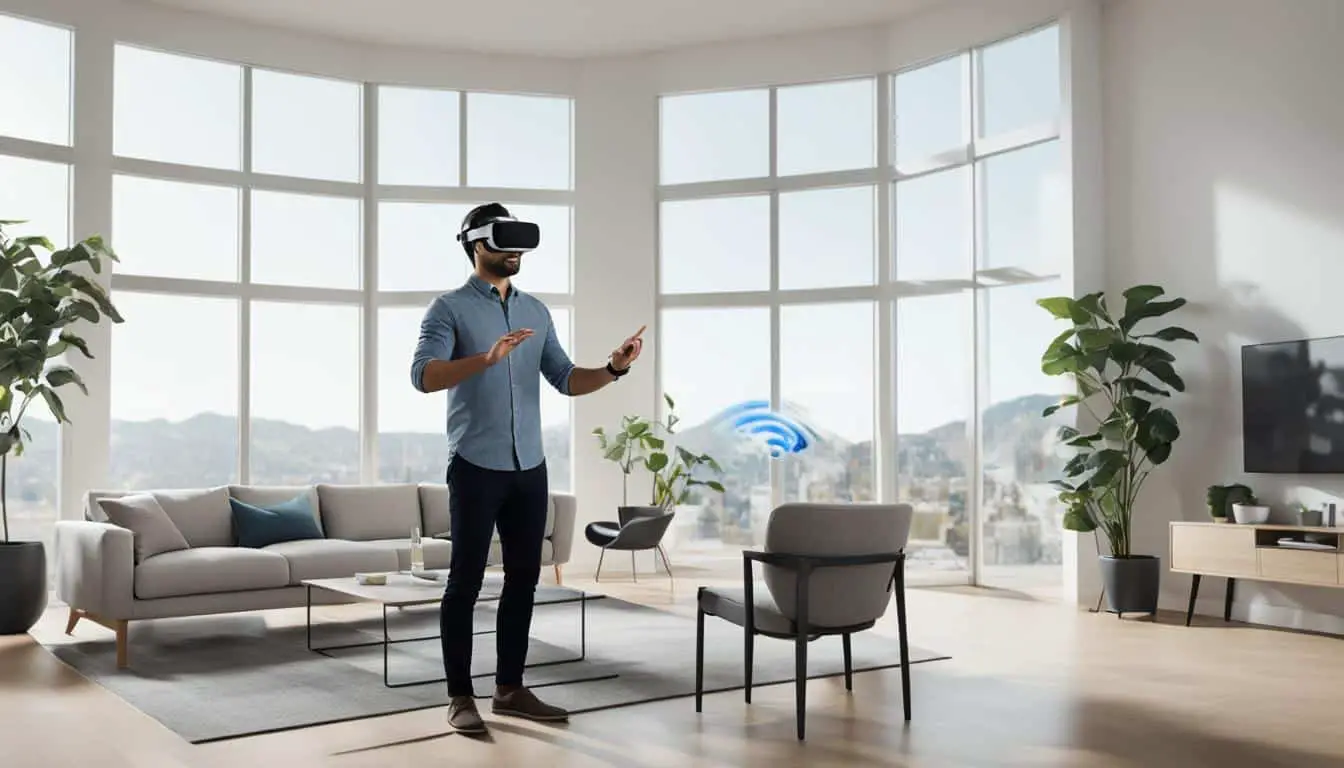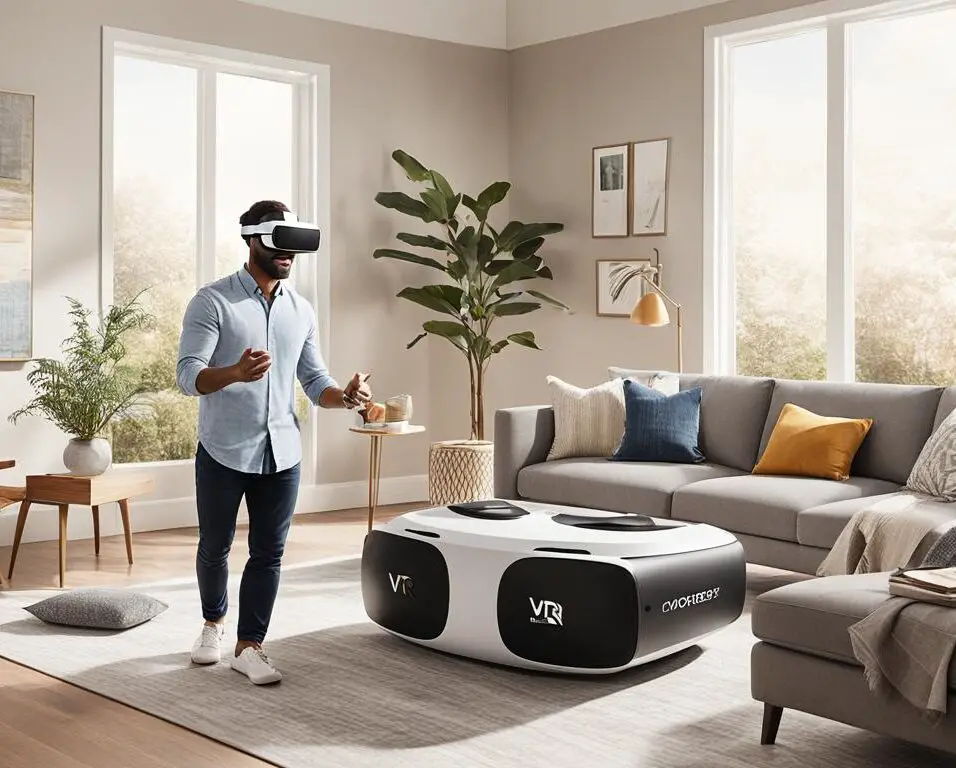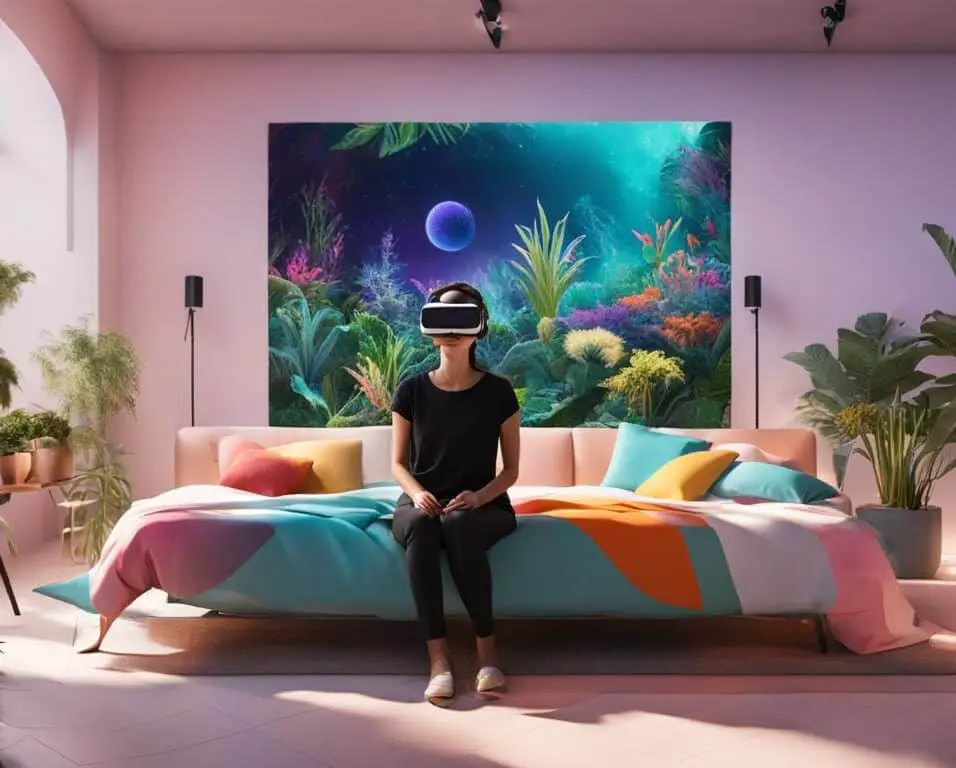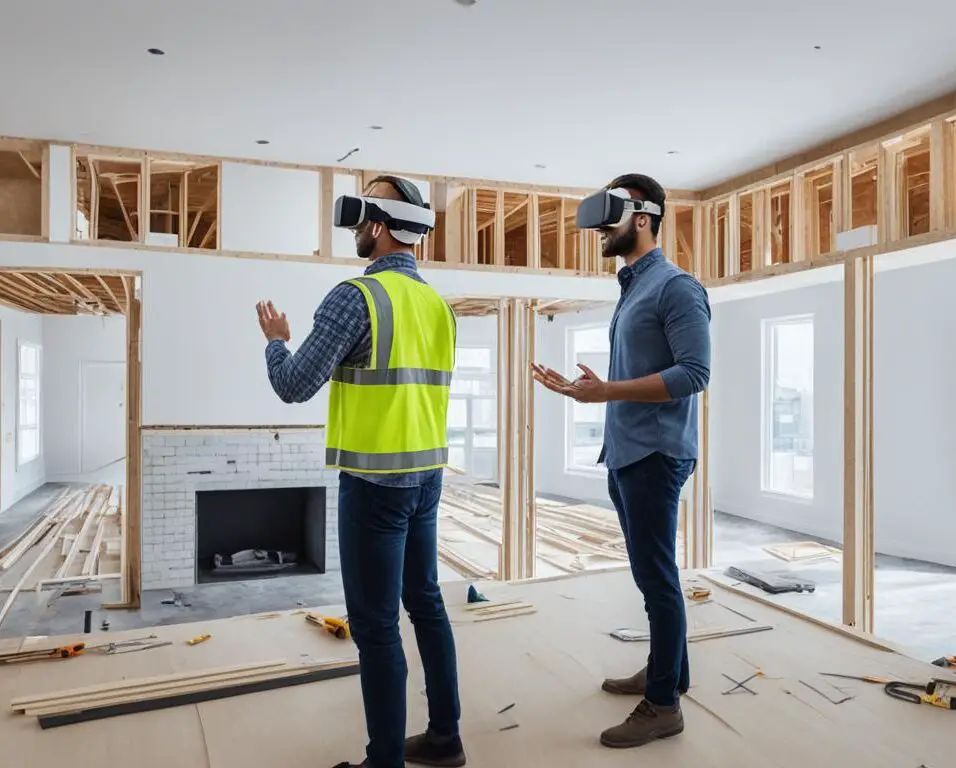Next-Gen Living: Creating Smart Home Systems with VR
Welcome to the future of living, where virtual reality (VR) technology is revolutionizing the way we create and interact with smart home systems. By harnessing the power of VR and combining it with home automation, homeowners can now seamlessly control various aspects of their homes with immersive and intuitive experiences.
Key Takeaways:
- VR technology is transforming how we create and interact with smart home systems.
- By integrating VR and home automation, homeowners can have immersive and intuitive control over their homes.
- VR offers a visual representation of the home, enhancing user experience and customization.
- Remote access and control are possible with VR, allowing homeowners to manage their smart home systems from anywhere.
- VR-enhanced automation takes smart home systems to the next level with personalized scenarios and convenience.
The Integration of VR and Smart Home Systems
The integration of VR technology into smart home systems allows homeowners to experience a new level of control and interaction with their living spaces. By combining virtual reality with home automation, users can immerse themselves in a virtual representation of their homes and easily manipulate various devices and systems through intuitive interfaces.
“The integration of VR and smart home systems revolutionizes the way we interact with our homes. It brings a sense of immersion and control that traditional interfaces cannot replicate.” – John Davis, Smart Home Enthusiast
Imagine putting on a VR headset and stepping into a virtual replica of your home. With the help of motion controllers, you can navigate through rooms, interact with objects, and access and control devices such as lights, thermostats, security systems, and entertainment systems. The virtual environment seamlessly integrates with the physical automation systems, allowing for a truly interactive and engaging experience.
Immersive Control with Virtual Reality
With VR technology, homeowners can have an unprecedented level of control over their smart home systems. By visually navigating through their virtual homes, they can easily locate and adjust devices without the need for physical interaction. Whether it’s dimming the lights, changing the temperature, or playing music, VR enables users to control their homes with natural gestures and movements, providing a more intuitive and immersive experience.
| Benefits of VR Integration | Description |
|---|---|
| Enhanced User Experience | VR technology creates a more engaging and interactive user experience, making home automation enjoyable and accessible to all. |
| Intuitive Control | Navigation through virtual homes and interacting with devices using motion controllers offers a simplified and intuitive way of controlling smart home systems. |
| Seamless Integration | Virtual reality seamlessly integrates with physical home automation systems, enabling users to manipulate devices in real-time. |
Moreover, VR interfaces can provide visual representations of technology integration, making it easier for homeowners to understand and manage their smart home systems. With virtual reality, users can see a comprehensive overview of their devices and sensors, allowing them to monitor and optimize their homes’ energy efficiency, security, and comfort levels.
By merging the immersive capabilities of VR technology with the convenience of smart home systems, homeowners can create a seamless and personalized living experience. Whether it’s controlling devices, customizing settings, or monitoring the home remotely, VR integration takes home automation to a whole new level.
Benefits of VR for Creating Smart Home Systems
VR technology offers numerous benefits for creating smart home systems. Firstly, it provides a more intuitive and immersive user experience, enhancing the way homeowners navigate and control their home automation devices. By wearing VR headsets and using motion controllers, users can seamlessly interact with their smart home systems, making the experience more engaging and enjoyable.
In addition to the enhanced user experience, VR offers a visual representation of the home, allowing users to visualize and customize their space. Through virtual reality, homeowners can explore different interior design options, experiment with furniture placement, and get a realistic sense of how their home will look before making any changes. This visual aspect of VR empowers users with the ability to personalize their living environment to their unique preferences and needs.
Furthermore, VR enables remote access and control of smart home systems. With VR technology, homeowners can manage their smart homes even when they are physically away. Whether they are at work, on vacation, or simply out and about, users can conveniently monitor and adjust various aspects of their home, such as lighting, heating, security, and entertainment systems, all from the immersive interface of their VR headset.
“VR technology allows homeowners to have a personalized and immersive experience when interacting with their smart home systems, making control and customization more intuitive and engaging.”
Real-Time Data Visualization and Monitoring
In addition to the above benefits, VR technology can also provide real-time data visualization and monitoring for smart home systems. Through VR interfaces, users can access detailed information and analytics about energy consumption, security alerts, and home automation data. This level of transparency and insight enables homeowners to make informed decisions about their energy usage, identify potential security risks, and optimize their smart home systems for greater efficiency and convenience.
| Benefits of VR for Creating Smart Home Systems | Explanation |
|---|---|
| Intuitive and immersive user experience | VR technology enhances the way homeowners navigate and control their smart home systems, providing a more engaging and immersive experience. |
| Visual representation and customization | VR allows users to visualize and customize their home’s interior, enabling them to experiment with different design options and furniture placement. |
| Remote access and control | Homeowners can manage their smart home systems from anywhere using VR, giving them the ability to monitor and adjust various aspects of their home even when they are not physically present. |
| Real-time data visualization and monitoring | VR interfaces provide users with detailed information about energy consumption, security alerts, and home automation data, enabling them to make informed decisions and optimize their smart home systems. |
Enhancing Automation with VR
VR-enhanced automation takes smart home systems to the next level by adding a layer of virtual control. With VR, users can create personalized automation scenarios, such as setting up scenes for different occasions or automating routines based on specific triggers. For example, homeowners can use VR to program their smart home systems to adjust lighting and temperature automatically when they enter a virtual “movie night” scene, creating a truly immersive and convenient experience.
By harnessing the power of VR, smart home automation becomes more intuitive and engaging. Users can seamlessly navigate through virtual interfaces, interacting with their smart home devices in a way that feels natural and immersive. Controlling lights, thermostats, security systems, and entertainment systems becomes a visual and interactive experience, enhancing the overall convenience and efficiency of home automation.
One of the key benefits of VR-enhanced automation is the ability to create personalized scenarios. With VR, users can design and save specific scenes tailored to their preferences. Whether it’s a relaxing evening ambiance or a productive morning routine, homeowners can easily activate these scenarios through intuitive gestures and commands. This level of customization adds a new dimension to home automation, making it more personalized and adaptable to individual lifestyles.
Moreover, VR-enhanced automation allows for seamless integration with other smart home technologies. By connecting VR interfaces with voice assistants, sensors, and IoT devices, users can create intelligent home automation ecosystems that work together harmoniously. The synergy between VR and other smart technologies enables a comprehensive and unified control system, making it easier than ever to manage and optimize home environments.
The Future of VR-Enhanced Automation
The potential for VR-enhanced automation is vast, and we are only scratching the surface of its capabilities. As VR technology continues to advance, we can expect even more innovative applications in the field of smart home systems. For example, future developments may include gesture-based controls, haptic feedback, and enhanced visualizations to further enhance the user experience.
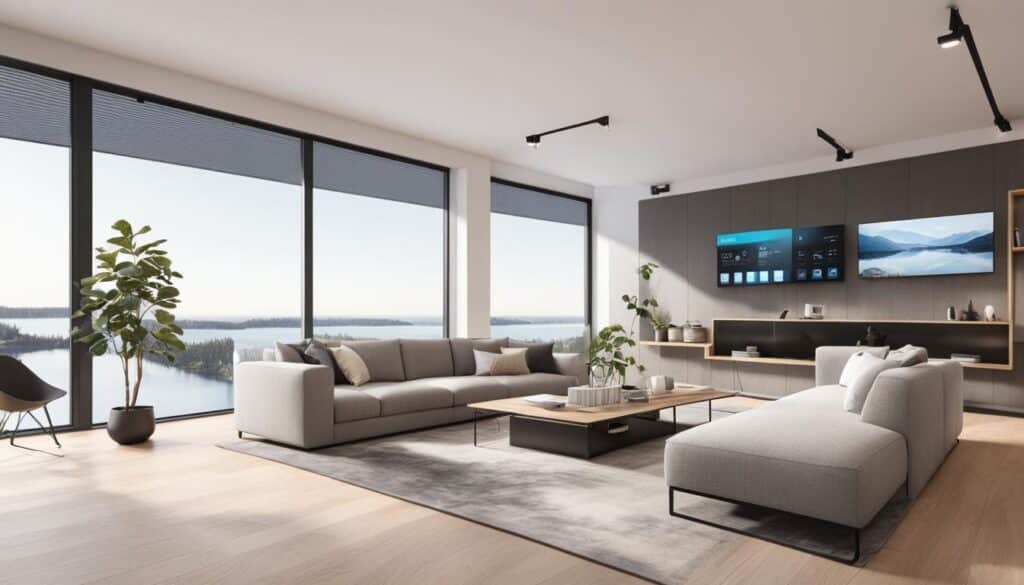
In addition to improving user interfaces, VR can also revolutionize the way we interact with our homes. Imagine being able to virtually walk through your home, adjusting and controlling devices with a simple wave of the hand. With VR-enhanced automation, homeowners can have a truly immersive and intuitive connection to their living spaces, enabling a seamless and integrated smart home experience.
| Benefits of VR-enhanced Automation | Challenges | Solutions |
|---|---|---|
| Enhanced user experience with immersive and intuitive controls | Cost of VR equipment and technology | Continued development and affordability of VR hardware |
| Personalized automation scenarios for different occasions | Robust and stable internet connectivity | Improved internet infrastructure and connectivity options |
| Seamless integration with other smart home technologies | Privacy and data security concerns | Implementation of robust security measures and protocols |
Future Applications of VR in Smart Home Systems
The future of smart home systems with VR holds immense potential for transforming various aspects of our everyday lives. As VR technology continues to advance, we can expect innovative applications that will revolutionize the way we interact with our homes and enhance our overall living experience.
Virtual Home Design and Remodeling
One exciting application of VR in smart home systems is in the field of home design and remodeling. With VR, homeowners can step into a virtual environment and visualize their space before making any physical changes. By creating virtual replicas of their homes, they can experiment with different designs, furniture arrangements, and color schemes, allowing for informed decision-making and ensuring that their vision is accurately translated into reality.
Enhanced Home Security through Virtual Surveillance
VR technology offers the potential to revolutionize home security by providing virtual surveillance and monitoring capabilities. With VR-enabled cameras strategically placed around the house, homeowners can monitor their property in real-time from any location. This virtual surveillance system can be accessed through VR headsets, providing a comprehensive view of the entire property and allowing for prompt detection of any suspicious activities or intrusions.
Advanced Telepresence for Remote Interactions
Another exciting application of VR in smart homes is advanced telepresence, enabling virtual connections and interactions with others in the home or remote locations. With VR, users can join virtual meeting rooms, attend family gatherings, or even participate in immersive virtual social events without physically being present. This technology opens up new possibilities for remote collaboration, socialization, and connectivity, bridging the gap between physical and virtual spaces.
“VR technology offers endless possibilities for enhancing our living spaces, from immersive design experiences to virtual surveillance and remote interactions.”
As VR technology continues to evolve, these future applications in smart home systems will enable homeowners to create personalized and immersive experiences tailored to their needs. The integration of VR into our daily lives will redefine the concept of home, offering boundless opportunities for creativity, convenience, and connectivity.
| Future Applications of VR in Smart Home Systems | Description |
|---|---|
| Virtual Home Design and Remodeling | Allows homeowners to virtually visualize and modify their space before making any physical changes. |
| Enhanced Home Security through Virtual Surveillance | Enables virtual surveillance and monitoring capabilities, allowing homeowners to monitor their property from any location. |
| Advanced Telepresence for Remote Interactions | Allows users to virtually connect and interact with others in their homes or remote locations, expanding social and collaborative possibilities. |
With these future applications, the potential of VR in smart home systems is vast. As technology continues to advance, we can look forward to a future where our homes are more immersive, secure, and interconnected, shaping the way we live and interact with our living spaces.
Overcoming Challenges and Limitations
While VR has immense potential for creating smart home systems, it also comes with its fair share of challenges and limitations. Addressing these obstacles is crucial to ensure the widespread adoption and success of VR in the realm of smart homes.
One of the primary challenges is the cost associated with VR equipment and technology. High-end VR devices, such as headsets and motion controllers, can be expensive, making them less accessible to a wider audience. Lowering the cost of VR hardware could significantly broaden its reach and enable more homeowners to experience the benefits of VR-enabled smart home systems.
Another limitation lies in the need for robust and stable internet connectivity. VR experiences heavily rely on a strong internet connection to provide seamless and lag-free interactions. Inadequate connectivity can hinder the user experience, causing frustrations and diminishing the overall appeal of VR in smart home systems. It’s essential to ensure reliable internet infrastructure to fully leverage the potential of VR technology.
Moreover, privacy and data security concerns need to be addressed to build trust and confidence among users. As VR becomes integrated into smart home systems, there may be apprehensions about the collection and storage of personal data. Stricter regulations and robust security measures should be put in place to safeguard user privacy and protect sensitive information from potential breaches.
Ensuring Accessibility and Affordability
One way to overcome the cost barrier is to encourage more manufacturers to produce affordable VR devices without compromising on quality. By fostering competition and innovation in the VR hardware market, prices can be driven down, making VR more accessible to a broader range of homeowners.
Enhancing Internet Infrastructure
To address the issue of internet connectivity, collaborations between VR technology providers and internet service providers (ISPs) are crucial. By working together, they can improve network infrastructure, ensuring stable and high-speed connections for seamless VR experiences in smart homes. Additionally, advancements in 5G technology and the proliferation of fiber optic networks can significantly enhance internet connectivity to support VR usage.
Prioritizing User Privacy and Security
To alleviate privacy and data security concerns, strict regulations and industry standards should be established to govern the use of VR in smart home systems. VR manufacturers and developers must prioritize data protection and implement robust security measures to safeguard user information. Providing transparent information about data collection and storage practices can also help build trust among users.
By addressing these challenges and limitations, the integration of VR in smart home systems can reach its full potential, revolutionizing the way we interact with our homes and enhancing our living experiences.
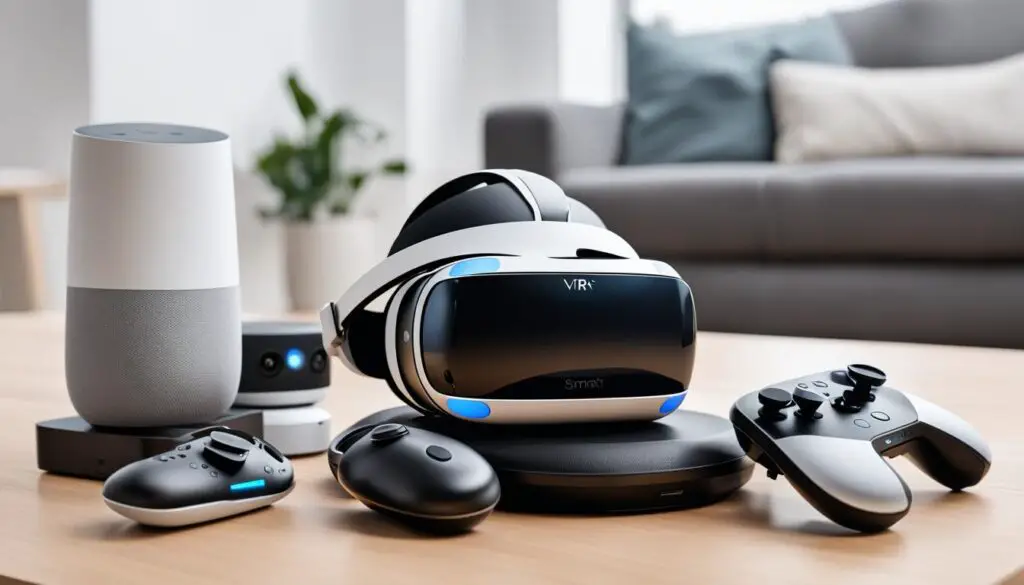
| Challenges | Limits |
|---|---|
| Cost of VR equipment and technology | Access to a wider audience |
| Robust and stable internet connectivity | Seamless and lag-free experiences |
| Privacy and data security concerns | User trust and confidence |
The Future of VR in Smart Home Systems
The rapid advancements in VR technology are paving the way for an exciting future in smart home systems. As VR hardware becomes more affordable and user-friendly, homeowners are increasingly embracing and adopting VR as a means of controlling their smart homes. With immersive experiences seamlessly integrated into everyday living, the future holds immense potential for VR technology.
Technological advancements such as augmented reality (AR) and mixed reality (MR) are poised to further enhance the integration of virtual and physical environments in smart homes. These advancements will offer even more immersive and interactive experiences, pushing the boundaries of what is possible in home automation.
VR-enabled smart home systems have the ability to revolutionize the way we live, making daily tasks more streamlined and convenient. From controlling lighting and temperature to managing security systems and entertainment devices, VR brings a heightened level of interactivity and personalization to home automation.
Additionally, the virtual representations of homes created through VR technology can facilitate improved home design and remodeling experiences. Homeowners can visualize and modify their space virtually, allowing for more informed decision-making before making physical changes. This not only saves time and money but also ensures a more customized and satisfying living environment.
The future holds great promise for VR in smart home systems. As the technology continues to evolve, we can expect even more seamless integration, enhanced visualizations, and personalized experiences. The possibilities are endless, and the future of living in smart homes is set to be an immersive and captivating journey.
With ongoing advancements and innovations in VR technology, the future of smart home systems is an exciting frontier. By combining virtual reality with automation and connectivity, homeowners will experience a level of control and interactivity that was once unimaginable. Get ready to step into a world where your home becomes an immersive and personalized sanctuary.
Conclusion
The integration of virtual reality (VR) technology with smart home systems is transforming our understanding of future living. By combining the immersive and intuitive experiences of VR with seamless home automation, homeowners can enjoy personalized control over their homes like never before.
VR technology offers numerous benefits for creating smart home systems. Its intuitive interface allows homeowners to easily navigate and interact with their home automation devices. The visual representation of the home in VR enables users to visualize and customize their living space, enhancing their overall living experience. Additionally, VR opens up opportunities for remote access and control, ensuring homeowners can manage their smart homes even when they are away.
While there are challenges and limitations to address, the future of VR in smart home systems holds enormous potential. As VR hardware becomes more accessible and user-friendly, more homeowners can leverage VR for seamless and efficient control over their homes. Technological advancements such as augmented reality and mixed reality will further enhance the integration of virtual and physical environments in smart homes, elevating home automation to a new level of immersion and interactivity.
FAQ
What is the integration of VR and smart home systems?
The integration of VR and smart home systems allows users to control their homes through virtual reality interfaces. By wearing VR headsets and using motion controllers, users can navigate and interact with a virtual representation of their home, accessing and controlling devices such as lights, thermostats, security systems, and entertainment systems.
What are the benefits of VR for creating smart home systems?
VR technology offers several benefits for creating smart home systems. Firstly, it provides a more intuitive and immersive user experience, allowing homeowners to easily navigate and control their home automation devices. Secondly, it offers a visual representation of the home, enabling users to visualize and customize their space. Additionally, VR allows for remote access and control, meaning homeowners can manage their smart home systems even when they are not physically present.
How does VR enhance automation in smart home systems?
VR-enhanced automation takes smart home systems to the next level by adding a layer of virtual control. With VR, users can create personalized automation scenarios, such as setting up scenes for different occasions or automating routines based on specific triggers. For example, homeowners can use VR to program their smart home systems to adjust lighting and temperature automatically when they enter a virtual “movie night” scene, creating a truly immersive and convenient experience.
What are the future applications of VR in smart home systems?
The future of smart home systems with VR is promising, with potential applications in various areas. For instance, VR can be used for home design and remodeling, allowing homeowners to virtually visualize and modify their space before making any physical changes. Additionally, VR can enhance home security by providing virtual surveillance and monitoring capabilities. Furthermore, VR can enable advanced telepresence, allowing users to virtually connect and interact with others in their homes or remote locations.
What are the challenges and limitations of VR in smart home systems?
While VR has immense potential for creating smart home systems, there are challenges and limitations that need to be addressed. One challenge is the cost of VR equipment and technology, which may limit its accessibility to a wider audience. Additionally, VR requires robust and stable internet connectivity to ensure seamless and lag-free experiences. Moreover, there may be concerns regarding privacy and data security when using VR in smart home systems, which need to be addressed to ensure user trust and confidence.
What does the future hold for VR in smart home systems?
The future of VR in smart home systems looks promising, with ongoing advancements in VR technology. As VR hardware becomes more affordable and user-friendly, more homeowners may embrace and adopt VR for controlling their smart homes. Additionally, technological advancements such as augmented reality (AR) and mixed reality (MR) may further enhance the integration of virtual and physical environments, offering even more immersive and interactive experiences in smart homes.



